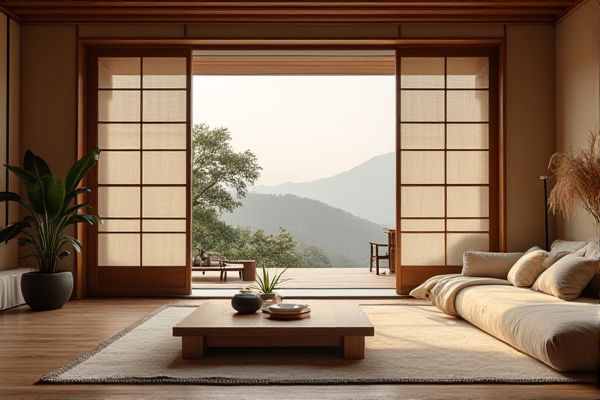
Folding screens offer a compact design that maximizes portability by allowing the device to unfold into a larger display, while sliding panels provide seamless multitasking with smooth transitions between screen sizes without increasing the device's footprint significantly. Explore this article to find out which innovative design better suits your needs and enhances your user experience.
Table of Comparison
| Feature | Folding Screen | Sliding Panel |
|---|---|---|
| Operation Type | Folds accordion-style | Slides horizontally or vertically |
| Space Efficiency | Requires clearance when folded | Maximizes floor space, glides along track |
| Installation | Simple, freestanding or wall-mounted | Requires track system, wall or ceiling mounted |
| Material Options | Wood, fabric, paper, metal | Glass, wood, aluminum, composite panels |
| Use Cases | Temporary privacy, decor, room division | Permanent partitions, closet doors, room dividers |
| Durability | Moderate, flexible joints may wear | High, robust track and panels |
| Cost | Generally lower | Typically higher due to installation and materials |
| Aesthetic Flexibility | Varied designs, easily changed | Modern, sleek, less flexible |
Introduction to Folding Screens and Sliding Panels
Folding screens consist of multiple hinged panels that can be easily folded to save space or create flexible room dividers, often made of wood, fabric, or metal. Sliding panels move horizontally along tracks, offering smooth, space-efficient partitioning ideal for closets, doors, or room separations. Both solutions provide versatile interior design options, catering to different functional and aesthetic needs in residential and commercial spaces.
Design Differences Between Folding Screens and Sliding Panels
Folding screens consist of multiple hinged panels that can be easily folded and expanded to create flexible room dividers or decorative accents, offering portability and dynamic spatial division. Sliding panels operate on tracks, allowing smooth horizontal movement to partition spaces without requiring additional floor space, providing a sleek, modern aesthetic and efficient use of room layouts. The design differences emphasize folding screens' versatility and traditional charm, while sliding panels deliver streamlined functionality and contemporary appeal.
Space Optimization: Which Saves More Room?
Folding screens save more room by collapsing into a compact stack, making them ideal for small spaces where width is limited. Sliding panels require wall space for the track and panel movement, which can reduce usable floor area but offer seamless integration into the room layout. For maximizing space optimization, folding screens provide greater flexibility in tight quarters, while sliding panels benefit larger areas with available wall clearance.
Aesthetic Appeal: Style and Versatility Comparison
Folding screens offer a classic, decorative aesthetic with intricate designs and customizable panels, making them ideal for adding a touch of elegance and versatility to any space. Sliding panels provide a sleek, modern style with clean lines and minimalistic appeal, perfect for contemporary interiors requiring flexible spatial division. Both options enhance room functionality while catering to different design preferences, balancing aesthetic appeal and practical use.
Installation and Maintenance Requirements
Folding screens require straightforward installation, typically needing wall mounts or ceiling tracks and minimal structural modifications, while sliding panels often demand more precise track alignment and secure fittings to ensure smooth operation. Maintenance for folding screens involves regular lubrication of hinges and checking for fabric wear or frame alignment, whereas sliding panels necessitate frequent cleaning of tracks to prevent debris buildup and periodic adjustments to rollers or glides for optimal sliding performance. Both systems benefit from routine inspections, but sliding panels generally require more attentive upkeep to maintain their mechanical components.
Privacy and Sound Insulation Capabilities
Folding screens offer moderate privacy and limited sound insulation, making them suitable for defining spaces visually without blocking noise significantly. Sliding panels provide enhanced privacy with better soundproofing properties, as they often feature tighter seals and more solid materials that reduce sound transmission. Your choice depends on whether you prioritize flexible space division or stronger acoustic separation.
Materials and Durability: Pros and Cons
Folding screens are typically made from lightweight materials like wood, fabric, or paper, offering portability and easy setup but can suffer from wear and tear over time due to repeated folding. Sliding panels often utilize more robust materials such as glass, metal, or solid wood, providing enhanced durability and stability but may require more complex installation and maintenance. Your choice between folding screens and sliding panels should consider the balance between material resilience and ease of use based on your specific space and functional needs.
Cost Comparison: Budget Considerations
Folding screens generally incur higher upfront costs due to their intricate hinge mechanisms and custom design options, making them less budget-friendly for large-scale applications. Sliding panels often offer a more economical alternative, with simpler installation processes and more affordable materials reducing overall expenditure. When prioritizing cost-effectiveness, sliding panels typically present a better option for budget-conscious projects without sacrificing functional versatility.
Best Use Cases for Folding Screens
Folding screens excel in spaces where flexible room division and compact storage are essential, making them ideal for small apartments, studios, or open-plan offices. Their ability to easily fold away when not needed allows you to quickly transform your living or working area without permanent alterations. Unlike sliding panels that require fixed tracks, folding screens offer portability and versatile placement, enhancing privacy and aesthetic appeal in transient spaces.
Best Use Cases for Sliding Panels
Sliding panels are ideal for maximizing space efficiency in small rooms or areas where a traditional swinging door or folding screen might obstruct movement. Their smooth, linear operation allows for easy partitioning of open-plan spaces, such as offices, living rooms, and conference rooms, without compromising natural light or sightlines. Your choice of sliding panels can enhance accessibility and modern aesthetics, especially in contemporary interiors requiring sleek and seamless room separation.
 homyna.com
homyna.com